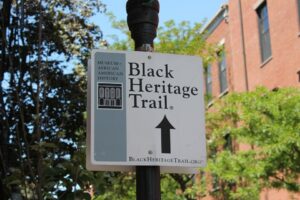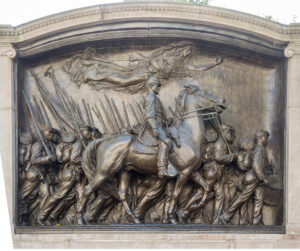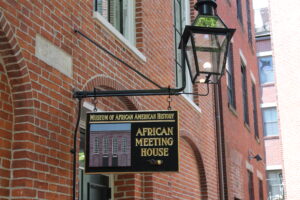By David Wilkening
Contributing Writer

BOSTON – Sure sounds like a movie: Starting out, an enslaved couple, Lewis and Harriet Hayden escape from Kentucky. They turn their Boston home into one of the U.S.’s best-known “safe houses” for runaway enslaved people. But the story does not end there. In a surprising plot development, Lewis Hayden becomes a legislator, recruiting soldiers that included the Civil War’s all-black 54th Regiment.
Self-directed or guided options
That all really happened with one genuine Hollywood twist: The historic 54th Regiment’s story later became a popular and fact-based movie, “Glory.” The Hayden home was a prominent part of the Underground Railroad, the secret network of people and buildings that harbored runaways from the South. It and the memorial dedicated to the 54th are both stops along Boston’s Black Heritage Trail, which can be self-guided or led by a National Park Ranger guide. Many visitors prefer the latter.
“They get more details of the history of the area before, during and after the American Civil War,” said Shawn P. Quigley, who has led tours for ten years as a National Park Ranger.

“Very interesting history and a nice walk through a beautiful neighborhood. But it’s far easier to understand the history and get a better perspective with a knowledgeable guide to elaborate on the events that happened here,” reported one visitor.
The Freedom Trail is undoubtedly Boston’s best-known trail but a growing interest in the issues surrounding slavery continue to spur the Black Heritage Trail’s popularity. It attracts visitors of all ages and backgrounds but has some special appeal to older visitors who usually find the approximate 1.5-mile route “easily walkable,” according to Quigley.
The trail is known for sharing the “largest collection of historic sites relating to life within a free Black community prior to the Civil War.”
If you’ve ever wondered why Boston was a leader in the pre-Civil War abolitionist movement, you’ll find some answers via the trail. The trip also helps explain why it became known as part of the Underground Railroad and a sanctuary shelter for escaped enslaved people. Quigley’s own favorite stops are the Hayden home and the 54th regiment memorial.
One of earliest states to abolish slavery
One major reason for the city’s prominence was that it was the capital and largest city in one of the earliest states to abolish slavery. As a port city, it also was a crucial avenue of escape. Most of the well-known freedom seekers arrived by sea as stowaways on ships from Southern ports, according to historical accounts.
The approximately 90-minute tour begins across the street from the 54th Regiment Memorial in front of the Massachusetts State House. It ends at the Museum of African American History.

“Most sites along the trail remain private residences,” as National Park signs point out. But the final stops at the Abiel Smith School and the African Meeting House are part of the museum. The tour is free but admission is required at the museum. It is $8 for seniors.
Beacon Hill is one of nine historical districts in Boston. The brick-and-cobblestone-covered neighborhood that was once home to the Underground Railroad was the first of the city’s historic districts, designated in 1955. Beacon Hill is believed to have acquired its name from a beacon that at one time sat on a hill to warn residents about foreign invasions.
Stops along the trail include homes, schools, churches and other gathering places during those tumultuous times. Many of them have their own designations.
A major facet of the 54th Regiment, led by 25-year-old Col. Robert Gould Shaw (played by Matthew Broderick in the movie) was that it was the first appearance of an estimated 200,000 black soldiers who fought in the war. The statue commemorating the regiment by Augustus Saint-Gaudens is regarded as a masterpiece.
Safe house visited by ‘Uncle Tom’s Cabin’ author
Husband and wife Lewis and Harriet Hayden’s home had the distinction of being visited by Harriet Beecher Stowe in 1853 as she was working on her famed anti-slavery novel, “Uncle Tom’s Cabin.”
The Abiel Smith School was the first schoolhouse in the nation built for the sole purpose of educating Black students. Another stop, the African Meeting House, was a key center of the spiritual, cultural and political events of the times. It was a church, school, and gathering place for political activists who included Frederick Douglass and William Lloyd Garrison.
“It’s the oldest still-standing African-American church, going back to 1806,” said Quigley.
Yet another stop is the George Middleton House. It was built by Middleton and Louis Glapion at 5 Pinckney Street and finished in 1787. It is the oldest existing home on Beacon Hill. Both owners were known as prominent abolitionists. Middleton’s occupation was a “horse breaker.” Glapion was a hairdresser. Unlikely occupations for heroes…but then again, it also sounds like another script for Hollywood.
RELATED CONTENT:
Storyteller and vocalist embodies her passion for history onstage (fiftyplusadvocate.com)
Edna Pruce – Breaking barriors while advocating for others (fiftyplusadvocate.com)












